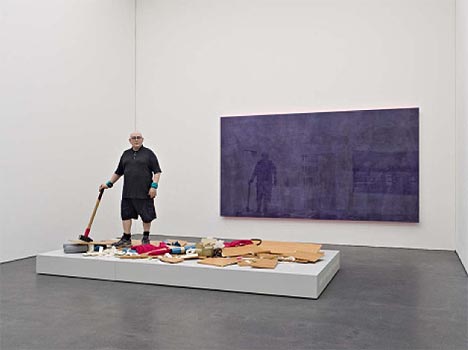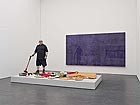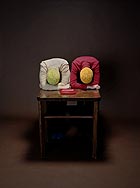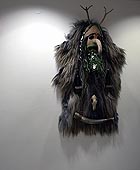
translated and summarized by: Liz Wollner-Grandville,
English summary March 2 - 8
Kunstmuseum Luzern: Urs Lüthi – Art is the better life
Art is the better life
Urs Lüthi’s “Numbergirls”, a photo series consisting of 20 androgynous self-portraits, glance lasciviously from the walls of the Kunstmuseum Luzern. It was these photos that made Lüthi, born 1947, to one of the shooting stars of the Swiss art scene in the 70s; and to this day the aesthetically stringent black-and-white photos have lost none of their fascination.
Self-portraits are the artist’s leitmotiv and make his works easily identifiable, despite some harsh stylistic breaks, which one regularly comes across in his work. They are a kind of style characteristic in themselves. Lüthi is successful at transferring individual motifs, especially the image of his head, from one creation phase to the next. The works are hung in such a way that they enter a dialogue with one another. They offer an insight into the artist’s working methods and his creations in their entirety.
In the 90s, Lüthi discovered the perfect style to catch the audience’s attention: the brash colours, large formats, concise slogans and shiny surfaces of the advertising world. The boundaries between art and non-art disappeared on a visual level, while they continued to exist on a contextual and content level. Lüthi is not advertising a sellable product, rather he tries to advertise art and its potential to uncover and question social norms, stereotypes, and ideals. Despite his continuous struggle for inspiration, Lüthi adheres to his maxim: “Art is the better life”, the precept he created on the occasion of his participation at the Venice Biennial in 2001.
Sylvia Mutti
Kunstmuseum Luzern
6002 Luzern, Europaplatz 1, until 10.05.09
www.kunstmuseumluzern.ch
Momentum: Nina Rike Springer – Lucid Episodes
The view is decisive
Confusion as the outcome of all communication forms and different languages is what Nina Rike Springer attempts to illustrate in her solo exhibit of photo- and video works in “Lucid Episodes”. In her works, Springer succeeds in conveying a visual awareness of the own “self” circulating around its environment, which is in continuous motion.
Photography is not a solitary dimension for the Carinthian artist: it has more to do with the discovery and approach to projects, and ultimately their implementation and processing. “Lucid Episodes” is supported by the presence of human beings. Springer attempts to offer the observer an “easy insight” into her own moods. Her “modus Vivendi” is composed of movement or standstill as an emotional condition, transmissions between real and virtual space, and the composition of everyday objects. A massive object, in a continuous interaction with the movements of a person, sharp colour contrasts, and well-arranged extra details form the framework. A serious discourse with everyday life coupled with childish buffoonery and individual mythological self-staging accompanies the exhibit like a golden thread.
The renowned painter Eugène Delacroix once said: the foremost obligation of a painting is for it to be a festival for the eye. Since the invention of photography it was possible to demonstrate in great detail how diversified human beings are in their lebensraum. Springer accomplishes both of these elements.
Alexander Lass
Momentum
1040 Vienna, Schleifmühlgasse 1, until 12.03.09
www.momentum.co.at
Galerie Göttlicher: Sam Ott/Reinisch. Architecture
Spatial time loop
Architecture is a complex and multilayered affair. The stunning and professional photos of completed buildings are actually only the highlights of the final handover. Innumerable decisions and many barriers had to be overcome before this stage was reached. The project path - ranging from the initial idea to the construction site – undergoes many phases of mutations.
“One week of designing, three years of planning”, is the rule of thumb for Franz Sam and Irene Ott-Reinisch. Over the past 8 years, more than 150.000 hours of work and a two-digit million-euro sum have been invested into the projects. “Transition”, their exhibition at the Gallery Göttlicher, not only presents what has actually been built, but points to the multilayered relationships, the communication, and the decision processes behind these creations.
20 staff members show their work on the 2.20 m tall vinyl plate hung from the ceiling of the gallery’s old arches, which spans 30 meters in a spiral-formed arc.
It took 10 days to complete the layout of this spatial loop, which circles the orbit of the universe of Sam-Ott-Reinisch’s office. The travel through time of this creative cosmos begins in the year 2000 and leads from the mission statement to webcam images of four large construction sites; among them the Kremser Kunstmeile, the Loisium, the Loisium Hotel and the ice rink in St. Pölten. Numerous other projects are also shown at this exhibit - ranging from a purification plant in Niederhollabrunn to a training hotel currently being constructed in Bhutan.
This exhibition reminds of a nomad’s carpet into which the most important events of a lifetime are woven. If one follows the initials and the dates, a door of insight opens into the dense net of relations and communication processes – a basis without which architecture would not be possible.
By Isabella Marboe
Galerie Göttlicher
3500 Krems-Stein, Steiner Landstr. 88, until 21.03.09
www.galerie.goettlicher.at
Thomas K. Lang Gallery: Jason Bunton – We approach the hollows at dawn
Utopia and rebellion
Reminiscences of his youth in the Ozarks, a mountain and forest region in the Midwest, are the central theme of Jason Bunton’s works. This is where he and his friends dreamt up their own fantasy world, which was in sharp contrast to the intolerant country life. Fantasy literature and role-playing scripts offered the cues.
Here they met nonconformists, stigmatized creatures, knighted by their traumata, raddled by alcohol and excesses. In Bunton’s paintings, these outcasts of small town universes are depicted as deer and crows.
The drawings convey an awareness of life that is closely connected to resistance, rebellion, and corresponding pop- and rock music soundtracks.
Bunton’s films are re-enactments of a form of utopia. But the players all wear jeans under their costumes; something which can easily be detected, and they actually know what they are doing. The Ozark plot could easily be transferred to the Wienerwald, and the slogan: “off to the lowlands at dawn” is valid.
Monika Schwärzler
Thomas K. Lang Gallery
1220 Vienna, Webster University, Berchtoldgasse 1, 3rd Floor, until 20.03.09
www.webster.ac.at
Mehr Texte von translated and summarized by: Liz Wollner-Grandville


 Teilen
Teilen





